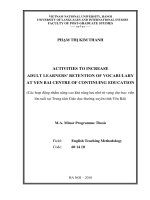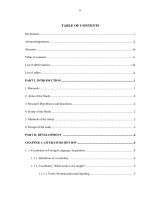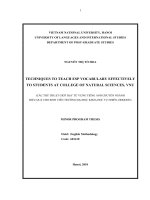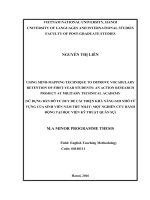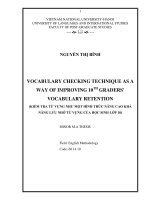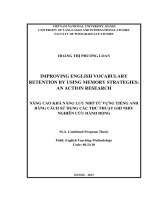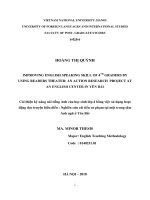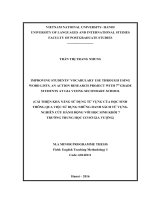Improving English vocabulary retention by using memory strategies An action research = Nâng cao khả năng lưu nhớ từ vựng tiếng Anh bằng cách sử dụng các thủ th
Bạn đang xem bản rút gọn của tài liệu. Xem và tải ngay bản đầy đủ của tài liệu tại đây (6.26 MB, 136 trang )
VIETNAM NATIONAL UNIVERSITY, HANOI
UNIVERSITY OF LANGUAGES AND INTERNATIONAL STUDIES
FACULTY OF POSTGRADUATE STUDIES
HOÀNG THỊ PHƯƠNG LOAN
IMPROVING ENGLISH VOCABULARY
RETENTION BY USING MEMORY STRATEGIES:
AN ACTION RESEARCH
NÂNG CAO KHẢ NĂNG LƯU NHỚ TỪ VỰNG TIẾNG ANH
BẰNG CÁCH SỬ DỤNG CÁC THỦ THUẬT GHI NHỚ:
NGHIÊN CỨU HÀNH ĐỘNG
M.A. Combined Program Thesis
Field: English Teaching Methodology
Code: 60.14.10
HANOI – 2013
VIETNAM NATIONAL UNIVERSITY, HANOI
UNIVERSITY OF LANGUAGES AND INTERNATIONAL STUDIES
FACULTY OF POSTGRADUATE STUDIES
HOÀNG THỊ PHƯƠNG LOAN
IMPROVING ENGLISH VOCABULARY
RETENTION BY USING MEMORY STRATEGIES:
AN ACTION RESEARCH
NÂNG CAO KHẢ NĂNG LƯU NHỚ TỪ VỰNG TIẾNG ANH
BẰNG CÁCH SỬ DỤNG CÁC THỦ THUẬT GHI NHỚ:
NGHIÊN CỨU HÀNH ĐỘNG
M.A. Combined Program Thesis
Field: English Teaching Methodology
Code: 60.14.10
Supervisor: Phạm Thị Hạnh, M.A.
HANOI – 2013
iv
TABLE OF CONTENTS
TABLE OF CONTENTS
PAGE
Candidate‘s statement………………………………………………………………
i
Acknowledgement………………………………………………………………….
ii
Abstract……………………………………………………………………………
iii
List of tables and figures……………………………………………………………
vii
PART A: INTRODUCTION……………………………………………………
1
1. Statement of the problem and rationale for the study……………………………
1
2. Aims of the study and research questions………………………………………
3
3. Significance of the study…………………………………………………………
4
4. Scope of the study………………………………………………………………
4
5. Methods of the study……………………………………………………………
5
6. An overview of the rest of the paper……………………………………………
6
PART B: DEVELOPMENT………………………………………………………
7
CHAPTER 1: LITERATURE REVIEW………………………………………
7
1.1. Language Learning Strategies……………………………………
7
1.1.1. Definition of Language Learning Strategies………………………….
7
1.1.2. The importance of Language Learning Strategies in Language
Learning and Teaching………………………………………………
9
1.1.3. Features of Language Learning Strategies…………………………….
10
1.1.4. LLS – a sufficient condition for successful learning? ………………
12
1.2. Vocabulary and Vocabulary Learning Strategies…………………………
13
1.2.1. Vocabulary
1.2.1.1. Definition ……………………………………………………….
13
13
1.2.1.2. The importance of vocabulary in second language learning……
14
1.2.1.3. Vocabulary retention and memory systems‘ process of working
14
1.2.2. Vocabulary learning strategies (VLS)…………………………………
17
1.2.2.1. Definition ………………………………………………………
17
1.2.2.2. Classification of VLS……………………………………………
18
1.3. Memory strategies…………………………………………………………….
24
1.3.1. Definition of memory strategies…………………………………………
24
v
1.3.2. Why memory strategies?
24
1.3.3. Classification of Oxford‘s Memory strategies…………………………
25
1.3.3.1. Grouping………………………………………………………
27
1.3.3.2. Associating…………………………………………………….
27
1.3.3.3. Using imagery…………………………………………………
28
1.3.3.4. Placing a new word into a context…………………………….
29
CHAPTER 2: METHODOLOGY………………………………………………
30
2.1. The background of the study………………………………………………
30
2.1.1. The study setting ……………………………………………………….
30
2.1.2. Participants……………………………………………………………
31
2.1.3. Materials………………………………………………………………
31
2.1.4. TOEIC and TOEIC vocabulary…………………………………………
33
2.2. Implementation of the Action Research……………………………………
34
2.3. Data collection instruments………………………………………………….
36
2.3.1. Vocabulary Knowledge Scale ………………………………………….
36
2.3.2. Interview…………………………………………………………………
37
2.3.3. Pre-test and post-tests ……………………… ………………………….
38
2.3.4. Learners‘ diaries.…………………………………………………………
39
2.3.5. Questionnaire.…………………………………………………………
40
2.4. Data collection procedure…………………………………………………….
41
2.5. Methods and data analysis procedures……………………………………
43
CHAPTER 3: FINDINGS AND DISCUSSION…………………………………
45
3.1. Research question 1…………………………………………………………
45
3.1.1. Results from VKS………………………………………………………
45
3.1.2. Result from the interview…………………………………………………
46
3.2. Research question 2…………………………………………………………
50
3.2.1. Results from the immediate post-test ………………………… …… …
3.2.2. Results from the delayed post-test ……………………………………….
50
53
3.3. Research question 3…………………………………………………………
56
3.3.1. Results from learners‘ diaries ……………………………………………
56
3.3.2. Results from the self-report column in the immediate post-test …………
58
vi
3.4. Research question 4…………………………………………………………
59
3.4.1. Students‘ attitudes towards the strategy training scheme…………………
59
3.4.2. The students‘ attitudes towards four sub-memory strategies……………
62
3.4.3. Students‘ suggestions for future program………………………………
63
CHAPTER 4: RECOMMENDATIONS…………………………………………
67
4.1. Strategy training…………………………………
67
4.2. Suggested activities for introducing and practicing memory strategies
72
4.3. Other recommendations for teachers………………………………………
72
PART C: CONCLUSION…………………………………………………………
74
1. Major findings of the study………………………………………………………
74
2. Limitations of the study………………………………………………………….
75
3. Suggestions for further study…………………………………………………….
76
REFERENCES…………………………………………………………………….
77
APPENDICES
I
Appendix 1: Vocabulary teaching schedule………………………………………
II
Appendix 2: Schmitt‘s taxonomy of VLS…………………………………………
IV
Appendix 3: Oxford‘ taxonomy of LLS…………………………………………
VI
Appendix 4: VKS test………………………………………………………………
VIII
Appendix 5: Pre-test/post-test 1/post-test 2………………………………………
X
Appendix 6: Questionnaire…………………………………………………………
XVI
Appendix 7: Sample of in-class & at-home handouts……………………………
XVIII
Appendix 8: Sample of learners‘ diaries……………………………………………
XXVIII
Appendix 9: Suggested activities employing memory strategies…………………
XXXIX
vii
LISTS OF TABLES, FIGURES, AND ABBREVIATIONS
TABLES
PAGE
Table 1: Definitions of Language Learning Strategies……………………………
8
Table 2: Features of Language Learning Strategies………………………………
10
Table 3: A collection of some important principles needed to retain vocabulary
items……………………………………………………………………………….
16
Table 4: Gu & Johnson‘s taxonomy of VLS………………………………………
20
Table 5: Nation‘s taxonomy of VLS………………………………………………
21
Table 6: Oxford‘s memory strategies……………………………………………
25
Table 7: Student profile……………………………………………………………
31
Table 8: Schedule of vocabulary teaching for TOEIC A class……………………
32
Table 9: Students‘ problems in independent learning vocabulary…………… …
49
Table 10: Strategies used as reported in students‘ diaries……………… ……
51
Table 11: Report of strategies used in the immediate post-test…… ……………
52
Table 12: Mean scores gained by the group in the pre-test and immediate post-
test…………………………………………………………………………………
52
Table 13: Individuals‘ performance in the pre-test and immediate post-test…….
53
Table 14: Mean scores gained by individuals in the pre-test and immediate post-
test…………………………………………………………………………………
55
Table 15: Mean scores gained by the group in the pre-test and delayed post-
test…………………………………………………………………………………
55
Table 16: Individuals‘ performance in the pre-test, immediate post-test and
delayed post-test………………………………………………………………….
57
Table 17: Mean scores gained by individuals in the pre-test, immediate post-test
and delayed post-test………………………………………………………………
58
Table 18: Students‘ preference of four sub-memory strategies……………………
62
Table 19: Students‘ suggestions for future program……………………………….
63
Table 20: Types of strategy training……………………………………………….
67
FIGURES
Figure 1: Diagram of Direct Strategies…………………………………………….
23
viii
Figure 2: Diagram of Indirect Strategies…………………………………………
23
Figure 3: Action research circle……………………………………………………
34
Figure 4: Data collection procedure………………………………………………
41
Figure 5: Results from VKS test…………………………………………………
45
Figure 6: The whole group‘s performance in the pre-test and immediate post-
test………………………………………………………………………………….
51
Figure 7: Individuals‘ performance in the pre-test and immediate post-test………
52
Figure 8: The whole group‘ performance in the pre-test and the delayed post test
54
Figure 9: The whole group‘ performance in the pre-test, immediate post-test and
delayed post-test……………………………………………………………………
54
Figure 10: Individuals‘ performance in the pre-test, immediate post-test and
delayed post-test……………………………………………………………………
56
Figure 11: Strategies used as reported students‘ diaries………………………….
57
Figure 12: Importance of the strategy training scheme…………………………….
59
Figure 13: Effectiveness of the strategy training scheme………………………….
60
Figure 14: Pleasure during the strategy training scheme…………………………
61
Figure 15: A model for strategy training…………………………………………
68
ABBREVIATIONS
LLS: Language Learning Strategies
VLS: Vocabulary Learning Strategies
L2: Foreign Language
VKS: Vocabulary Knowledge Scale
M: Mean Score
TOEIC: Test of English for International Communication
1
PART A: INTRODUCTION
This chapter sheds light on the statement of the problem and rationale for the study
as well as its aims and research questions. Moreover, the scope and the significance of the
study are also presented in this part. Lastly, the chapter concludes with an overview of the
rest of the paper, serving as a useful compass to help the reader stay on track throughout
the research.
1. Statement of the problem and rationale for the study
―I’m sure that I have seen this word before but…I do not remember its meaning. Sorry
teacher.‖
―Teacher, could you tell me the best way to learn vocabulary? I have tried a lot but it is
always easy for me to forget the meanings of words that I have learned.”
“At first, I can remember all the words that you have taught us but… after a few days,
it seems to be very difficult for me to recall their meanings although they look really
familiar to me.”
“I can’t remember all things about a word, like how to pronounce it, whether it is a
verb or a noun, when I can use it…”
“Teacher, how can I remember the words that I have learnt?”
…
Those are questions and comments that my students often share with me. They all
know the importance of learning vocabulary; however, they seem to be frustrated with
trying to learn new words. This can be shown by the way they express themselves in
English confusingly; their gesture of slightly scratching their head when they have to deal
with words that they do not know; and their low marks in vocabulary test. From this
reality, a challenging question is set for teachers of English in general and me - one teacher
of English in particular: “How to help students retain vocabulary effectively?‖
From my own experience as a student, I used to ask myself a question like my
students now: “How can I remember this word?” It was very easy for me to understand the
meaning and get the right pronunciation of a word at first, but it was also easy for me to
forget those things a short time later. It therefore resulted in bad marks in my reading
comprehension tests and the way I tried to use suitable words when I had to present in
class. One day, there appeared an idea in my mind – that I think is a turning point in the
way I have dealt with learning vocabulary: that was the time when my teacher gave us an
2
example to explain the meaning of the word: ―embarrassed‖. She said, ―Just imagine, you
are in a restaurant with a very important person and you carelessly pour your entire café
cup on his clothes….yup and that will be the time you feel so “embarrassed”. So we all
understood that ―embarrassed‖ showed the feeling when we did something wrong and we
did not know what to do then. I myself think that this associating way is very simple but
really impressive and effective. As a result, I remember that word for my life. Thus, after
graduating from university and being an English teacher, I started to study the very first
readings about Vocabulary and Vocabulary Learning.
Vocabulary plays an important part in language learning as Schmitt (2010) stated,
―Learning vocabulary is an essential part of mastering a second language‖ (p. 4). This
view has been strongly approved by all partners involving in learning process. For
example, McCarthy (1990, p.viii) added ―no matter how well the student learns grammar,
no matter how successfully the sounds of L2 are mastered, without words to express a
wider range of meanings, communication in an L2 just cannot happen in any meaningful
way‖. The learners will certainly face difficulties when communicating in English without
equipping themselves with necessary vocabulary items. Furthermore, vocabulary
deficiency can be reason for weakness in many language skills, namely reading and
listening comprehension, speaking competence, writing performance and grammatical
accuracy. Learning vocabulary is no doubt an indispensable step of L2 acquisition.
However, learning but not remembering is not successful learning. Students should be
taught how to remember vocabulary or recall necessary vocabulary when needed. In
general, they must be provided the way to process information deeply.
Studying VLS has been an interest for a great deal of psychologists, linguists and
language teachers for a long time. There are numerous studies conducted about VLS, their
effectiveness in learning vocabulary. Almost these researchers have attempted to develop a
framework of category of VLS. They are: O‘Malley and Chamot (1990), Oxford (1990);
Stoffer (1995); Gu and Johnson (1996), Schmitt (1997), Nation (2001), to name but a few.
At the University of Languages and International Studies, Vietnam National
University, Hanoi, vocabulary learning and teaching ―have yet to receive adequate
attention‖ and that ―vocabulary is often integrated into other communicative skills and the
task of vocabulary acquisition is totally left to students. Also, the research interest among
the university staff and students has seemingly moved away from this field‖ (Ngo, 2009, p.
3
2). He also critically pointed out that at post-graduate library where research papers in
English were deposited, lecturers‘ research on vocabulary could hardly be found. Besides,
he also described a dramatic fall in the number of graduation papers concerning about this
issue by giving out some alarming figures: ―while up to 9 graduation papers in 1998 dealt
with vocabulary, the figure dropped to 4 in 1999 and only 1 in 2002, and 2003‖. In May,
2009, he himself conducted a research on ―Vocabulary Level and Vocabulary Strategies of
ULIS First Year Mainstream English Majors‖. In this research, he aimed at finding out the
vocabulary level of the first year students, what strategies they used in their vocabulary
learning and what problems they encountered with vocabulary learning strategies.
This research took no attempt to fill the gap in changing and correcting the previous
scholars‘ VLS systems, identifying the vocabulary level or the numbers of vocabulary
strategies used among students, but practically focused on applying some specific
strategies in vocabulary learning and examining their effectiveness.
In conclusion, with all the reasons from my own experience, my teaching and
learning situation and the large gap in studying VLS in my university, I would like to
devote my time and effort researching to my thesis: ―Improving English Vocabulary
Retention by using Memory Strategies- An Action Research” as an answer to the very
beginning question - ―How to help my students retain vocabulary effectively?”.
2. Aims of the study and research questions.
Initially, the study aimed at identifying the problems with vocabulary that students
were facing with. Secondly, it was intended to improve the students‘ vocabulary retention
by teaching them some helpful memory strategies, namely grouping, associating, using
imagery and placing new words into a context. The study also aimed at finding out how
much students obtained the memory strategies learnt; by the way, the strategy used the
most by students could also be revealed. Finally, it attempted to collect not only students‘
attitudes towards the strategy training scheme in general and four sub-memory strategies in
particular but their own suggestions for a better future teaching and learning program as
well.
In short, the study was conducted to answer the four following research questions:
1. What are the problems that the students encounter in their independent
vocabulary learning?
4
2. How does learning the 4 sub-memory strategies help to improve students'
vocabulary retention?
3. How much do the students obtain the memory strategies learned in their
independent learning?
4. What are the students’ attitudes towards teaching and learning the 4 sub-
memory strategies and their suggestions for future teaching and learning
program?
3. Significance of the study
In spite of not being the trailblazing study on the application of learning memory
strategies on vocabulary retention, this one would be of great benefit for the students who
are learning English in general and the ones who are dealing with TOEIC vocabulary in
particular, their teachers, and other researchers who are interested in the topic.
To begin with, the treatment in the research hoped to hand over students a new way
of approaching vocabulary learning, escaping from the traditional way of listing and
learning by heart new words. Especially, the recommendations of the research would not
only help students to deal with vocabulary problems of impending TOEIC Test, but also
improve their life-long vocabulary studying since ―vocabulary learning never stops, even
long after grammar system is firmly in place‖ (Thornbury, 2002, p. 160).
As for TOEIC instructors in particular and teachers dealing with English
vocabulary in general, the findings of the study could be a source of references for them to
make a decision on how best to facilitate their students‘ lexicon extension.
Last but not least, regarding to the researchers sharing the same interest in
vocabulary, this study would be a reliable resource of related literature review and a good
reference for them to continue their future work.
4. Scope of the study
This study was conducted on 9 students ageing from twenty to twenty two in one
TOEIC class. These students came from different universities in Hanoi. They started the
course with rather limited knowledge about TOEIC test and their TOEIC scores at the
beginning of the course test ranged from 220- 395.
Taken from Oxford‘s (1990) classification of learning strategies, grouping,
associating, using imagery and placing new words into a context were four specific
memory strategies introduced in this thesis. With the application of these four memory
5
strategies, the teacher - researcher hoped to bring something new and effective in her
teaching vocabulary to her students to improve their vocabulary learning.
In this thesis, the number of vocabulary employed in the treatment was taken from
the book 600 Essential Words for the TOEIC (Lougheed, 2008). Vocabulary was then
categorized into different topics to deliver to students (see Appendix 1).
5. Methods of the study
The current action research combined both qualitative and quantitative approaches.
The action actually taken was a vocabulary learning strategy training scheme designed for
the duration of nine weeks.
5.1. Data collection methods
Data was collected by means of a Vocabulary Knowledge Scale (VKS) test,
interviews, learners‘ diaries, tests and questionnaires. Firstly, a VKS test and a group
interview took place before the treatment to identify students‘ problems when dealing with
vocabulary. Furthermore, a system of tests, namely pre-test, post-test 1 and post-test 2 was
employed to measure the improvement of students‘ vocabulary retention in terms of short-
term and long-term after being introduced four sub-memory strategies. In addition, during
the treatment, a number of diary entries which were weekly written by students helped to
point out the most popular strategies used by students. Finally, a questionnaire was
distributed via emails to students in order to collect the students‘ attitudes towards teaching
and learning the 4 sub-memory strategies and their suggestions for future teaching and
learning program.
5.2. Data analysis methods
The collected data was categorized under the four research questions. To be
specific, the data from the VKS test and a group-interview served to answer the first
question, the learners‘ diaries addressed the second one, the test scores for the third and
questionnaire data referred to the last question.
Regarding to the first question, in the VKS test, the students represented how much
they had known the word by marking it from 1 to 5 with reference to the 5 scales. The
teacher then counted the number of each mark for each student, expressed the figure as a
percentage and illustrated them in a bar chart. In the interview, after the students tried to
express their problems in vocabulary learning (both in Vietnamese and in English), the
data was translated, generalized, calculated, and described in a table.
6
Next, for the tests, mean scores of the pre-test, and two post-tests were computed
and compared with each other in pairs. By this way, the improvement of students‘
vocabulary retention in short term and long term could be revealed.
With reference to the third question, all the 144 learners‘ diary entries were
collected. The teacher then calculated the number of each strategy used in each entry.
These figures were then converted to percentages and given under the format of a pie-chart
to see the most popular strategies.
Finally, the data from questionnaire was independently analyzed according to three
different parts. The first part included three smaller questions addressing three aspects of
attitudes towards the strategy training scheme, namely the importance, the effectiveness
and the pleasure. For each question, the researcher then used calculating percentages to
illustrate the data and presented them in three different pie-charts. In the second part, after
counting all the marks given for each strategy, a mean score was identified. The strategy
having the highest mean score would be the most favorite one. In the last part, data was
counted, illustrated by percentages and displayed in a table so that the researcher could
make a conclusion of ideas and suggestions for the course, perceived by the students.
6. An overview of the rest of the paper
The rest of the paper is categorized into these following parts:
Part B: Development: is divided into three chapters:
• Chapter 1: (Literature review): introduces the theoretical foundations for the
whole study.
• Chapter 2: (Methodology): elaborates on the participants, the method used, the
instruments, the data collecting and the data analysis procedure.
• Chapter 3: (Results and discussion): presents and analyses all the correct data to
help find out the answers to the three research questions.
• Chapter 4: (Recommendations): presents the author‘s suggestions on the learning
and teaching vocabulary strategies based on the research findings and the related literature.
Part C: Conclusion: summarizes all the major points in the study, reveals the limitations
of the study and proposes some suggestions for further research.
7
PART B: DEVELOPMENT
CHAPTER 1: LITERATURE REVIEW
This chapter, as its name, provides an overview of the literature related to the
study, stretching from the larger to the smaller items in a unified language learning
system: from language learning strategies, then vocabulary learning strategies, next,
memory strategies and last four sub-memory strategies. Besides, this review also reveals
some critical analysis about the systems of classifying vocabulary learning strategies as
well as the research gap, thus motivating to carry out the study.
1.1. Language Learning Strategies
1.1.1. Definition
―Give a man a fish and he eats for a day. Teach him how to fish and he eats for a lifetime”.
Wenden (1985, cited in Griffiths, 2004)
The target of education is not for only today, but for a person‘s whole life. Thus, if
teachers just give students the answers, their immediate problems may be solved.
However, if they are taught the way to work out the problems by themselves, they can
manage their own learning during their life. Therefore, in language teaching and learning,
utilizing language learning strategies (LLS) is of great significance.
In order to understand what Language Learning Strategies (LLS) are, it is
advisable for the writer to provide a definition of ―strategy‖ first and explain why this term
was chosen for the current study.
As the basic meaning in military settings, ―strategy‖ was known as ―the
generalship/ the art of the war‖ or specifically as ―the optimal management of troops,
ships or aircraft in a planned campaign‖ (Oxford, 1990, p. 7). When moving to
educational field, the strategy concept has been transformed into ―learning strategies‖,
which commonly means ―operations employed by the learner to aid the acquisition,
storage, retrieval and use of information‖ (Rigney, 1978, cited in Oxford, 1990, p. 8).
Together with ―strategy‖, in his study, Griffiths (2004) also gave out a list of some other
alternative terms which are ―more or less synonymous‖ such as ―learning behaviours‖ by
Wesche (1977) and Politzer & Mc Groarty (1985); ―tactics‖ by Seliger (1984) and
―techniques‖ by Stern (1992) (p. 1). As the fact that Rubin (1975) used ―strategy‖ ―in
8
perhaps the earliest study in this area and it enjoys the widest currency today‖, ―strategy‖
is used as the official term for this study.
Defining LLS is still a controversial issue. There has been no general accepted
definition of LLS so far. The researchers tend to define LLS in their own way of teaching
context; as a result, different expressions have been given. Singleton (2008) has managed
to collect and illustrate some prominent definitions of LLS in the following table:
Table 1: Definitions of Language Learning Strategies (Singleton, 2008, p. 51)
9
Whereas the early definitions took more concerns about the outcome of LLS like
linguistic and sociolinguistic competence, regulating learners‘ learning, facilitating
learning; the recent ones tend to focus on the process and characteristics of LLS. Some
definitions are very broad, while the others seem to be rather specific. For instance, Rubin
(1987) mentioned about all things learners do to help regulate their studying; whereas, Ellis
(1995) just acknowledged LLS in terms of mental and behavior activity.
In general, from the table, LLS can be interpreted as ―specific actions, behaviors,
steps or techniques that learners used (often deliberately) to improve their progress in
developing their competence in the target language” (Singleton, 2008, p. 52).
1.1.2. The importance of Language Learning Strategies
Training students how to use LLS has been proved to give them a big help in
language learning. In Oxford‘s definition mentioned above, the significance of LLS has
been highlighted as one kind of ―weapons‖ which can ―make learning easier, faster, more
enjoyable, more self-directed, more effective and transferrable to new situations‖. Once the
learners are equipped with learning strategies, they will be more confident, more motivated
and more active in their own learning. In other words, learning strategies can help to
compensate the weakness in their learning style. However, it is not true that all the learners
who use learning strategies will be successful in studying language. Oxford (1990)
emphasized although ―strategies are especially important for language learning‖, only
―appropriate language learning strategies resulted in improved proficiency and greater self-
confidence” (p. 1). There have been many researchers studying the differences between
―good learners‖ and ―bad learners‖ in their ways of using strategies. Chamot (2004) stated,
―Differences between more effective learners and less effective learners were found in the
number and range of strategies used, in how the strategies were applied to the task, and in
whether they were appropriate for the task‖ (p. 18). The students with strategic way of
thinking and working will know what and how they should do to achieve success when
dealing with language skills. In academic field, this can be easily seen when comparing
them with the ones who do not use any kind of learning strategies or use strategies
inappropriately.
Moreover, language learning strategies are demonstrated to ―encourage greater
overall self- direction for learners‖ (Oxford, 1990, p. 10). Self-direction can be
acknowledged as the ability to be self-responsible and active in grasping new language.
10
Owing to the traditional education system, many learners are passive and ―spoon-fed‖
learners (Oxford, 1990, p. 10) who sit and wait until they are told what to do and how to
solve the problems. This makes their study more and more difficult and they themselves
certainly cannot catch up with the updated knowledge. LLS are expected to alter this kind
of attitude and behavior towards learning, change passive learners into self-directed ones
who can gradually gain more confidence, proficiency and involvement in learning process.
Obviously, LLS have played a very important part in language teaching and
learning. For more understanding about LLS, the nature and key features will be discussed
in the next part.
1.1.3. The features of Language Learning Strategies
Once teachers and learners get a good hold of LLS‘ characteristics, it is possible for
them to have a deeper and more precise understanding of LLS‘ concepts and a more
appropriate way of applying LLS in their own work.
This part briefly concerned about two approaches of Oxford (1990) and Singleton
(2008) when these two researchers presented the main features of LLS in their books.
In her book titled Language Learning Strategies – What Every Teacher Should
Know (1990), Oxford summarized some key features of LLS as follows:
Table 2: Features of Language Learning Strategies (Oxford, 1990, p. 9)
To begin with, LLS were discovered to help learners gain knowledge better, thus
have a function to orient learners to the target of learning language, communicative
11
competence. Learning strategies help learners to participate in authentic communication in
an active and effective way. The proof is that while ―social strategies provide increased
interaction and more empathetic understanding, two qualities necessary to reach
communicative competence‖, memory strategies help to ―understand and recalling new
information‖, and compensation strategies ―aid learners in overcoming knowledge gaps
and continuing to communicate authentically‖ etc (Oxford, 1990, p. 9).
Agreeing with Oxford about the contribution of LLS in stimulating learners‘ self-
direction, Singleton added ―LLS enable learners to self-regulate their own learning and
become autonomous and effective outside the classroom‖ (Singleton, 2008).
In terms of the change in teachers‘ role when applying LLS in language class, both
the two researchers confirmed its essential movement. If the traditional teacher in the past
was identified as a manager, a director, an instructor, a judge, a leader now they are
expected to become a helper, a guide, a consultant, a facilitator. This alteration does not
reduce the role of teachers, but strengthen their participations, make them more creative
and flexible in working environment. Changing teachers‘ roles also require full awareness
of responsibility and direction from learners. Once this can be done, the relationship
between teachers and learners as well as the effectiveness of teaching and learning will
certainly be guaranteed.
In addition, two scholars also shared the same view about the problem orientation,
action basis and involvement beyond just cognition of LLS. Obviously, learners often use
LLS when problems befall; for example, memory strategies are mobilized when there is
something necessary to be remembered; guessing strategies become useful when students
come up against a difficult foreign language reading. Besides, as ―LLS are specific actions
or techniques used by learners‖ (Wenden, 1987, cited in Singleton, 2008, p. 55), these
actions ―are naturally influenced by learners‘ more characteristics or traits, such as learning
style, motivation and aptitude‖. In addition, LLS do not only concern about ―mental
process or cognitive functions‖, but they also involve ―social, metacognitive and affective
aspects‖.
As for the observability of LLS, there is an agreement among researchers that some
of the LLS can be observed, while others cannot. For instance, when teachers use images
to illustrate the meaning of the words, students can have a look at them; however, when
mental associations are made, it is unobservable.
12
Both Oxford (1990) and Singleton (2008) admitted, ―The issue of consciousness and
LLS is still controversial. Many researchers agree, however, that LLS are often used
deliberately and consciously, but their use can become automatic, i.e. subconscious.‖ It can
be seen that whether LLS are ―conscious, potentially conscious or subconscious‖, it
depends on each learner and the task they are engaged in (Singleton, 2008, p. 55).
Besides, Singleton (2008) has discussed one more time some factors affecting the
choice of LLS which were formerly mentioned in Oxford. They can be degree of
awareness, stage of learning, task requirements, teacher expectations, age, sex, nationality,
general learning style, learner belief, motivation level and purpose of learning.
In short, almost twelve features of LLS listed in Oxford‘s study are mentioned and
restated in Singleton (2008), but there are still some differences. While Singleton (2008)
omitted teachability, Oxford (1990) highlighted it as one important feature of LLS by
proving that LLS are ―easier to teach and modify‖ through strategy training. She
considered such training a big help for students to learn why they should use LLS, when
they can use them and how they can flexibly utilize them in different situations.
Furthermore, to supplement for the system of LLS‘ characteristics, Singleton (2008,
p. 56) added two more features of systematization and finiteness. In the first place, when
studying LLS‘ systemization, he supported the view of Bialystok (1990), ―learners do not
incidentally discover a language strategy; they use them systematically on the basis of their
knowledge.‖ As an illustration, in ancient times, some kinds of memory devices were used
to help story tellers remember their lines. These techniques were still rather simple and
naturalistic. Throughout the history, when more and more knowledge is updated, strategies
have been changed by the best language users who gradually ranged language techniques
from naturalistic practice to analytic and rule-based ones (Oxford, 1990, p. 1). For the
finiteness of LLS, he considered LLS not an ―idiosyncratic creation‖ of each learner and
the number of LLS is limited and completely enumerated.
All in all, features of LLS have called a lot of interest from researchers and been
more and more fulfilled to accommodate learners with a comprehensive insight about
learning strategies in general and LLS in particular.
1.1.4. LLS – a sufficient condition for successful learning?
Although LLS are especially important for language learning, is using only LLS
enough for the learners to achieve success?
13
Nowadays, Communicative Language Teaching has been widely used and
prevailed in almost language schools in the world. This has brought about the movement
between the role of teachers and learners; a teacher-directed class has been moved to a
learner-directed one, in which a learner will have to learn the way to take control of their
own study. This heavy task cannot be fulfilled with just LLS. The saying goes: you can
bring a horse to water, but you cannot make him drink. In language learning field, the
importance of learners during language learning process should be highlighted. If a teacher
just provides his/her students with LLS without waking their awareness of self-learning,
proficiency cannot occur. Language learning is a life-long learning, the teacher can help
students today but not forever. Learners need to work through their whole life by
themselves. Therefore, it is the language teachers‘ duty to help their students become more
autonomous in their own study. Talking about this, another term called ―learner
autonomy‖ should be concerned.
―Learner autonomy‖ is considered a complicated concept to define, but for the
purpose of this thesis, a definition of Richards and Schmidt (2002) can be such a
satisfactory one: learner autonomy in language teaching ―is the principle that learners
should be encouraged to assume a maximum amount of responsibility for what they
learn and how they learn it‖ (p. 297).
In this thesis, the combination between the provision of LLS to students and the act
of waking up their responsibility in learning is carefully taken into account.
1.2. Vocabulary and Vocabulary Learning Strategies
1.2.1. Vocabulary
1.2.1.1. Definition
Vocabulary is considered a very important aspect of language, yet one of the major
challenges that L2 learners have to face during the process of learning a language. Before
discussing the significance of vocabulary, it is first necessary to clarify the working
definition of vocabulary. Originally, vocabulary dated from the Medieval Latin word
vocābulārium as perceived from the freedictionary.com. According to Oxford Advanced
Learner‘s Dictionary (7
th
edition, p. 1707), vocabulary can be defined as (1) ―all the words
that a person knows or uses‖ and (2) ―all the words in a particular language‖. In these
above senses, there appears the term ―words‖ for twice. Regarding the connection between
vocabulary and word, McCarthy (1990) stated, ―When we speak of the vocabulary of a
14
language, we are speaking primarily, but not exclusively, of the words of that language‖
(p.3). Also in the Oxford Advanced Learner‘s Dictionary (7
th
, p. 1758), word ―is a single
unit of language which means something and can be spoken or written‖. In short, as the
researcher‘s perception, word is somewhat the representation of vocabulary in spoken or
written form.
In addition, in terms of vocabulary teaching and learning, vocabulary should not be
recognized as individual or separated words with fixed meanings. More than that, it can be
a combination of words such as collocations (make a complaint, have breakfast…), multi-
word units (it‘s amazing how, well and truly…), polywords (at the weekend/ in his
opinion…), institutionalized expressions (I‘ll take it, I got it…) or even sentence frames
(there is/ there are…) (Lewis, 1993, pp. 92-94)
1.2.1.2. The importance of Vocabulary
―…without grammar, very little can be conveyed, without vocabulary nothing can be
conveyed‖
David Wilkins (1972, cited in Thornburry, 2002, p. 13)
Above was the way that David Wilkins, a British linguist acknowledged vocabulary
and the significance of vocabulary. Thornburry (2002) once more emphasized this by
restating an advice given to the students in the course book titled Innovations, ―If you
spend most of your time studying grammar, your English will not improve very much. You
will see most improvement if you learn more words or expressions. You can say very little
with grammar, but you can say almost everything with words‖.
In terms of second language teaching and learning; however, vocabulary had been
ignored for such a long time. In the past, when the Direct Method and Audiolingualism
prevailed, teaching of grammatical structures attracted special concern. The advent of the
Communicative Approach since 1970s has raised awareness of the key role of teaching and
learning vocabulary. Much more attention has been given to the vocabulary research, in
which researchers have attempted to find the relationship between learning strategies and
language competence, the factors enhancing vocabulary acquisition, and so on.
1.2.1.3. Vocabulary retention and memory systems’ process of working
In the Oxford Advanced Learner‘s Dictionary (2005), retention is defined as ―an
ability to remember things‖ (p. 1297). There is also another definition in the website
, in which retention in learning can be defined as ―the ability to
15
retain facts and figures in memory‖. Although no definition of vocabulary retention in the
literature has been found by the researcher, for the purpose of this study, vocabulary
retention can be clarified as the storage of vocabulary in the memory, which becomes
available for usage when needed.
As mentioned above, learning vocabulary is an essential part of mastering a
language. To achieve vocabulary, learners not only have to learn but to remember a lot of
words. Indeed, ―learning is remembering‖ (Thornburry, 2002, p. 2). He also added the fact
that remembering words is not something like remembering grammar as ―it is essentially a
rule-based system, vocabulary knowledge is largely a question of accumulating individual
items‖ (p. 2). Talking about the relationship between learning and remembering, people
mention about the connection between language exposure and memory. While the term
memory more often refers to later storage and retrieval of information, language exposure
refers more to processes in the initial acquisition or encoding of information. These two
factors have reciprocal relationship with each other. Information is learned only when it
can be retrieved later, and retrieval cannot occur unless information is learned.
Not only the relationship between language exposure and memory, but also the way
how information can be stored in the memory should be taken into consideration. Thanks
for this, it is entirely possible for us to explain why some chunks of information seem to
stay still, whereas some slip away quickly. This is no doubt a matter of concern for both
teachers and learners so as to promote effective learning and retention of new language
items.
Types of memory
The role of memory is crucial in any kind of learning and vocabulary learning is no
exception. What we usually think of as ―memory‖ in day-to-day usage is actually long-term
memory, but there are also important short-term store and working memory, which must be
worked through before a long-term memory can be established. (an-
memory.net)
Short-term store is defined as ―the brain‘s capacity to hold a limited number of
items of information for periods of time up to a few second. It is the kind of memory
involved in holding in your head a telephone number for as long as it takes to be able to
dial it; or to repeat a word that you‘ve heard the teacher modeling‖ (Thurnburry, 2002, p.
23).
16
Working memory can be thought of as the ability to remember and process
information at the same time. This is one kind of process when words are focused long
enough to perform operations on them. This is said to be the place where some cognitive
tasks such as reasoning, learning and understanding happen (Thornburry, 2002, p. 23). It
holds a small amount of information (typically around 7 items or even less) in mind in an
active, readily-available state for a short period of time (typically from 10 to 15 seconds, or
sometimes up to a minute) ().
Unlike working memory where the capacity to retain words is limited, long-term
memory has an enormous capacity and intends for storage of information over a long
period of time. However, Thornburry (2002) stated, ―the fact that learners can retain new
vocabulary items the length of the lesson (i.e. beyond the few seconds‘ duration of the
short-term store) but have forgotten them by the next lessons suggests that long-term
memory is not always as long-term as we wish. Rather, it occupies a continuum from the
―quickly forgotten‖ to the never forgotten‖ (p. 24). Thus, it is necessary for the language
learners to learn how to move information from the quickly forgotten to the never
forgotten. To do this, the support of some typical techniques plays such a very important
part. In his book How to Teach Vocabulary, Thornburry listed a number of principles
generalized from many research findings in the table follows:
Repetition
The time-honored way of memorizing new material is through repeated
rehearsal of the material while it is still in working memory. However,
simply repeating an item (rote learning) seems to have little long-term effect
unless some attempt is made to organize the material at the same time.
Retrieval
The act of retrieving a word from memory makes it more likely that the
learner will be able to recall it later.
Spacing
It is better to distribute the memory work across a period of time rather than
to mass it together in a single block. For example, when teaching students a
new set of words, it is best to present two or three items first, then go back
and check them, and then some more, and backtrack again…
Pacing
As having different learning styles, learners should be given opportunities to
pace their own rehearsal activities.
17
Use
Put words to use is the best way of ensuring they are added to long-term
memory.
Cognitive
depth
The more decisions the learners make about the word, and the more
cognitive demanding these decisions, the better the word is remembered.
Personal
organizing
The judgments that learners make about a word are most effective if they are
personalized.
Imaging
Easily visualized words are more memorable than words that don‘t
immediately evoke a picture.
Mnemonics
These are tricks to help retrieve items or rules that are stored in memory and
that are not yet automatically retrievable.
Motivation
The only strong motivation makes is that the learner is likely to spend more
time on rehearsal and practice, which in the end will pay off in terms of
memory.
Attention/
arousal
A very high degree of attention (arousal) seems to correlate with improved
recall.
Affective
depth
Just as it is important for learners to make cognitive judgments, it may be
also important to make affective judgments like ―Do I like the sound or look
of the word? Do I like the things that the word represents?‖
Table 3: A collection of some important principles needed to retain vocabulary items
(Adapted from Thornburry, 2002, pp.24-26)
The above part has revealed the operating process of three kinds of memory. The
challenge for a language learner is to transform material from short-term and working
memory into long-term memory as once the piece of information has been stored in long-
term memory; it can remain there for a very long time, and sometimes even for the rest of
one‘s life. (). Moreover, a number of effective techniques help to
retain vocabulary items has just been suggested in the above table. This thesis (using
memory strategies to improve vocabulary retention) is therefore completely reasonable and
practically conducted to test the effectiveness of the techniques in specific student subjects.
1.2.2. Vocabulary learning strategies
1.2.2.1. Definition
18
Vocabulary Learning Strategies (VLS) are one part of LLS which in turn are part of
general learning strategies (Nation, 2001). In a specific way, VLS can be concluded as
―specific strategies utilized in the isolated task of learning vocabulary in the target
language‖ (Singleton, 2008). However, it does not mean that VLS are only for vocabulary
learning, they can be found useful in other types of tasks. For instance, when identifying
the list of learning strategies used by successful learners, a few VLS was found such as
guessing a word‘s meaning from the context, identifying the grammatical category of a
word, looking up words, and so on (Hosenfeld, 1984, cited in Singelton, 2008, p. 52).
Conversely, some general learning strategies such as planning and assessment can be used
in learning vocabulary. Nation (2001) defined VLS with the following important features:
(1) they involve choice;
(2) they are complex, i.e. consisting of several steps;
(3) they require knowledge and benefit from training; and
(4) they increase the efficiency of vocabulary learning and use.
(cited in Singleton, 2008, p. 52)
While research into language strategy field dated from 1970s, by the 1990s, a
number of study on VLS were conducted. In many studies, a number of general LLS were
found to be VLS or be used for vocabulary learning. The reason may be ―learning
individual lexical items is more manageable than strategically tackling larger, more holistic
elements of language proficiency like the four skills or grammatical knowledge‖ (Schmitt,
2010). Some other studies oriented to the effectiveness of applying individual strategy in
vocabulary learning.
1.2.2.2. Classification of VLS
Starting from the 1990s, studying VLS has been an interest for a great deal of
scholars, linguists and language teachers. Besides a lot of studies about the relationship
between learning strategies and language competence, the differences between the better
learners and their peers in the way of using learning strategies or the factors affecting LLS,
VLS choice in learning and teaching, developing a comprehensive list or taxonomy of VLS
has also been paid attention to by many researchers. Among them were some prominent
ones such as Stoffer (1995), Gu and Johnson (1996), Schmitt (1997) and Nation (2001).
All these studies have attempted to present as complete a list of VLS as possible
